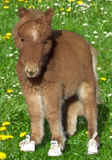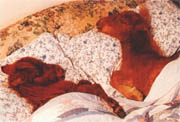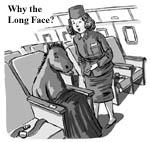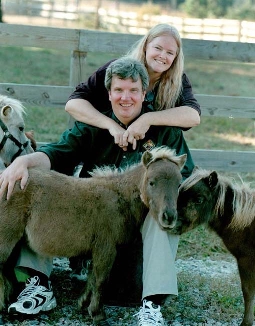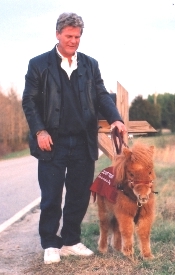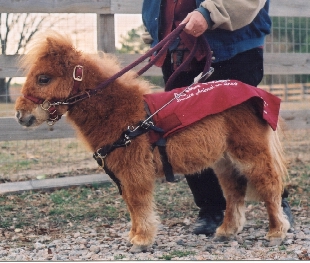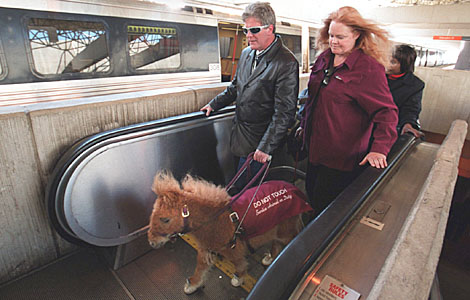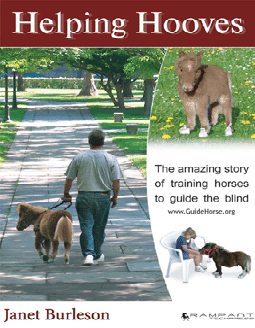|
|
Trainers lead horse to blind By H. Darr Beiser, USA TODAY ELLSWORTH, Maine — When Dan Shaw began losing his sight to retinitis pigmentosa almost three decades ago, he knew that he would eventually lose most of his independence and mobility. He considered getting a seeing-eye dog, but he had heard from other blind people who had had dogs that it was heartbreaking to part with their animals every seven to 10 years, when they had reached the end of their service life. The solution came riding in on a tiny horse named Cuddles. As Shaw and his wife were about to fill out an application for a seeing-eye dog in March 2000, they caught a Ripley's Believe It or Not TV segment about an experimental program training a small horse as a guide. "I was amazed that they had a little tiny horse that could actually lead the blind," Shaw says. "And it would live a long time. Horses that little could live for 35, 45 years. I thought that would be excellent to have for an animal." Shaw got in touch with Janet and Don Burleson, founders of The Guide Horse Foundation (www.guidehorse.com) in Kittrell, N.C., to see if he could get one. Shaw was the first of dozens of people to call, but no horses were available. A few months later, the Burlesons called him to say that mystery author Patricia Cornwell, who read about their efforts in a newspaper, had offered to pay for a horse and for the training they would need. "I felt blessed from that moment," says Shaw, 46, a craftsman whose sight is down to pinhole vision in one eye. "I couldn't believe it. I called every week to find out how Cuddles' training was doing." Janet Burleson trains the horses, which they pick from the smallest of the Miniature horse breed. Guide Horses are up to 26 or 27 inches tall and weigh up to 80 or 100 pounds. "Horses make excellent guides," she says. "It is very common in the wild state for a blind horse to bond to a sighted horse that it uses as its guide." The Guide Horse project, in fact, was born because the Burlesons had a Miniature horse as a pet and saw that Twinkie was companionable, willing and a natural guide. "Twinkie was our guinea pig, so to speak," says Burleson, a horse trainer for 35 years. Curiosity led them to training horses to help people. "We wanted to experiment with ways to use small horses as service animals. We decided to try to train a horse to see if a horse could guide a blind person." Not just any Miniature horse can be a Guide Horse. "Even if a horse is small enough, it might not have the appropriate intelligence or personality," she says. Guide Horses such as Cuddles are housebroken and tap their hooves by the door if they need to go out. Unlike guide dogs, they do not sleep in the house and require a small barn. "Horses are outdoor creatures," Burleson says. "They are trained to come indoors for working purposes." In March of 2001, Shaw flew to North Carolina for training. When he got off the plane, "Janet said there's somebody here who wants to meet you," Shaw says. "When I bent over to feel Cuddles, she gave me a kiss across my eyes, my forehead. She was everything I had thought and more. I felt like the luckiest man in the world." Shaw and Cuddles worked together for a week, including a plane trip to Atlanta in which a weather delay severely tested Cuddles' housebreaking. "We're talking about five hours on a plane," Shaw says. "But she never had an accident." After another month of training in May, Shaw took Cuddles home, stopping to visit in Washington and New York. They went to the top of the Empire State Building, and Cuddles lunched on grass at the base of the Statue of Liberty. Shaw built a tiny barn for Cuddles and has acquired a second Miniature, Nevada, to keep her company. Cuddles remains the only Guide Horse that the foundation has placed with a blind person, although there are nine horses in training now, with two scheduled to be placed this spring. "We're not in a hurry," Burleson says. "We really wanted to see how Dan and Cuddles did in daily life. Now we are comfortable." The Burlesons, who have a computer consulting business and raise Arabian horses, do the guide work for free in their spare time. Shaw says he has never been to a public place where Cuddles was not allowed. But within the visually impaired community, the reception to the program has been mixed. "There are blind persons who can't even imagine using an animal guide of any type," Burleson says. "And there are some who use guide dogs who couldn't imagine switching." Nonetheless, she thinks demand will grow. The Burlesons have about 80 people on their waiting list. For now, though, Cuddles remains a source of endless fascination for onlookers, right down to the tiny sneakers she wears to keep from slipping on hard surfaces. Wherever Shaw and Cuddles go around their little town of Ellsworth, they draw a curious crowd. Shaw never tires of talking to people and answering questions about Cuddles. The only problem is, "She is so damn cute everybody wants to pet her. They can't because she is a service animal (and petting could distract her from her job of keeping a blind person safe). I tell people they can come to my home and pet her when she's a horse and not working." Shaw says he and Cuddles have a special bond. "We are one now. We are a good team."
USA Today Pics |
Guides Training Press Photos News Apply FAQ Wishes Contact Home
|
|
Copyright © 1998 - 2005 by the Guide Horse Foundation Inc. Guide Horse ® Guidehorse ® and Helping Hooves ® are registered trademarks. |
The Guide Horse Foundation has the utmost respect for The Seeing Eye® and their seventy-two years of outstanding work with assistance animals for the blind. Even though the press often calls our horses "seeing eye horses", please note that The Guide Horse Foundation is not affiliated with or sanctioned by the Seeing-Eye® or any of the Guide Dog training organizations. Seeing-Eye® is a registered trademark of the Seeing-Eye, Inc.
y strap adjustment . Chuao IceRiver ALEO AE1 Lite www.iceriver.company/aleo-ae1-lite.html.
